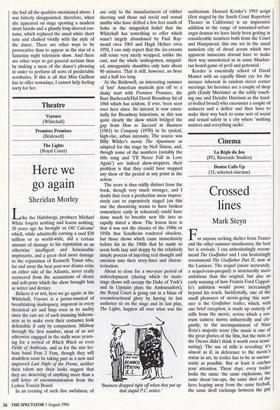Cinema La Regis du Jeu (PG, Riverside Studios)
Denise Calls Up (15, selected cinemas)
Crossed lines
Mark Steyn
For anyone seeking shelter from Twister and the other summer smasheroos, the best bet is revivals. I can unhesitatingly recom- mend The Godfather and I can hesitatingly recommend The Godfather Part II, now at the Lumiere. The sequel (more accurately, a sequel-cum-prequel) is structurally more ambitious than the original, but also an early warning of how Francis Ford Coppol- la's ambition would prove increasingly beyond his reach. Incidentally, one of the small pleasures of movie-going this sum- mer is the Godfather trailer, which, with one brief exception, is made up entirely of stills from the movie, across which a ros- trum camera moves unhurriedly and ele- gantly, to the accompaniment of Nino Rota's majestic score (the music is one of the great glories of the film, but the twits at the Oscars didn't think it worth even nomi- nating). The use of stills is revealing: it's almost as if, in deference to the movie's status as art, its trailer has to be as uncine- matic as possible. But at least it catches your attention. These days, every trailer looks the same: the same explosions, the same shoot-'em-ups, the same shot of the hero leaping away from the same fireball, the same droll exchange between the guy and the spunky gal sidekick, the same guy yelling `Go, go, go, go gounm
u If the Godfather movies point up the infantile regression of the Hollywood blockbuster during the last quarter-century, things aren't much better at the more self- consciously cerebral end. Jean Renoir's La Regle du Jeu and Hal Salwen's Denise Calls Up have curious thematic similarities, which is bad luck on the latter's part because the former is a masterpiece. Of course, Renoir's film, made in 1939, also has the- matic similarities with Beaumarchais, Da Ponte and Mozart: mistaken identity, spy- ing, go-betweens, the romantic convolu- tions of the gentry mirrored by those of the servants. But Renoir puts Beaumarchais's machinations in the machine age. We begin with Andre (Roland Toutain) landing at Le Bourget, having just flown the Atlantic solo. He should be triumphant, exhilarated. Instead, he's depressed because a certain marchioness isn't there to meet him: the thrills of technology are no compensation for the vicissitudes of love. As the drama unfolds, Renoir points up the contrast between the automated frenzy of the mod- ern world and the almost pathetic incapaci- ty of his principals. The camera dwells lovingly on surfaces mechanical and human: these are lives lived on the surface, though in the eyes we glimpse deeper feel- ings struggling to express themselves.
Salwen's film is a crass reduction of La Regle du Jeu's riches. It's a sort of L'Apres- Midi d'un Phone, strung on one modest idea: that these days we live our lives on the telephone. So Denise Calls Up begins with the morning after the night before: Linda is clearing up after her party, and Gale calls to ask how it went. 'Nobody showed up,' says Linda. 'Nobody?' says Gale. Nobody. And thus begins a story in which everything from birth to sex to death is conducted on the telephone — on cord- less phones, speakerphones, headset Phones, mobile phones, payphones, sky- phones, fax machines, call waiting and con- ference calls. You'd have thought that Doris Day and Rock Hudson's split-screen bathtub scene would have been the last work in phone sex, but here's the second example in a fortnight of what one charac- ter calls 'moan, groan, dial tone'; in The Truth about Cats and Dogs, we were sup- Posed to find the telephonic masturbation genuinely erotic; Salwen at least knows it's a joke, and takes it to its logical conclusion beds Jerry and Barbara lie in their respective ueds running the receivers up and down their bodies like vibrators. There's one striking post-coital shot of Jerry completely naked except for the handset discreetly covering his, er, handset. Unfortunately, that's the only memo- rable shot in the picture. Renoir's charac- ters seem helpless by comparison with the machines but at least they struggle to pur- sue their passions; in Denise Calls Up, they seem uniformly blank and passive. In La Regle, Renoir himself plays Octave, who
wanted to be an orchestral conductor but instead is merely a conductor of informa- tion and gossip between his amorous friends. At the end of the film, he resolves to be more than just a conductor, to get involved, to take part. There is no such development in Salwen's film. By the end, one character has died in a car crash while calling her friend — the earphone embed- ding itself in her brain and her death itself recorded for posterity on her chum's answering machine — but other than that everyone is exactly the same. This is a one- joke film: the characters' only hang-up is that they won't hang up. And, because of the conceit, every actor is forced to play his scenes in isolation, in an empty room, bark- ing his half of the conversation into the mouthpiece. It's strange how talking into a telephone is one of those things (playing newsreaders is another) that actors find incredibly difficult to do convincingly. This cast doesn't cut it: all the lines are dead.



















































 Previous page
Previous page